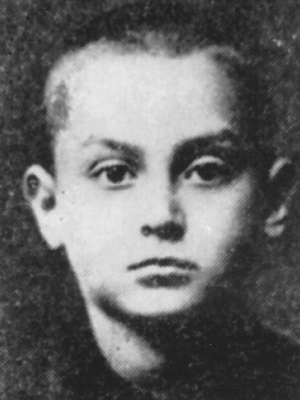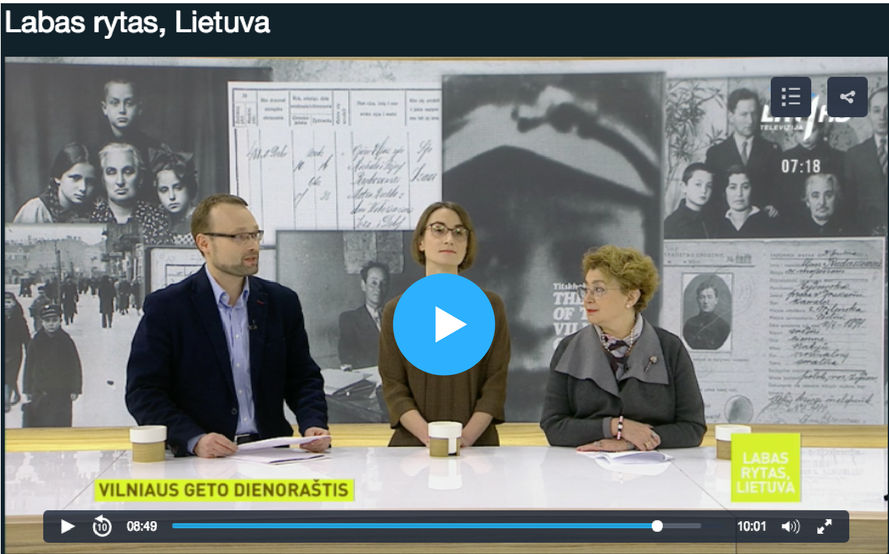
Yitzhak Rudashevski, the young chronicler of the Vilnius ghetto, would have turned 90 today (December 10). Imprisoned in the ghetto with his mature values and a gift for writing, he wrote down in his school notebook the reality around him, images of the ghetto, struggle and faith in the future.
Trapped in the ghetto and seeing the suffering, Yitzhak didn’t stop taking pride in his Jewishness and he wasn’t overcome by hopelessness and self-pity. On the contrary, his thirst for life propelled him forward.
“I am ashamed to be seen on the street, not because I’m a Jew but because I am ashamed of my powerlessness. The yellow patches are sewn to our clothes, but not to our minds. We are not ashamed of the patches! Let those who put them on us be ashamed,” he wrote in his diary.
The young man’s thoughts about the dignity of man and freedom might seem obvious today, but the entries from 75 years ago paint a much different picture of that period. They speak of a world where the concept of human rights didn’t exist. Taken in context, we marvel at the maturity, courage and talent it took for a teenager to write about what he did.
It is perhaps symbolic Rudashevski’s birthday coincides with International Human Rights Day, marking the day in 1948 when the General Assembly of the United Nations adopted the Universal Declaration on Human Rights.
The idea of the international community insuring the legal rights of the person and his protection at the national and international level only came about because of World War II and the Holocaust, which trampled upon shared human values and the value of human life.
The Council of Europe’s European Human Rights Convention adopted in 1950 followed fast upon the UN declaration and became an important document for protecting human rights and set an example in its application of the Universal Declaration on Human Rights in the European context.
In marking Human Rights Day it’s important to remember those who by their courage and spirit, sometimes long before their time, helped make the significance of these basic rights understandable. Very soon, in February, a Lithuanian translation of Rudashevski’s Vilnius ghetto diary will be published. His diary was written in Yiddish and it took a lot of time and effort to translate this record of authentic experience into Lithuanian.
A memory stone was placed at Rūdininkų street no. 8 in Vilnius in memory of Rudashevski in August of 2016 by the Lithuanian Human Rights Center and partners.
“I wish I could get back the last year and put it aside for the future, for a new life. But the other emotions I feel today are courage and hope. Not the slightest bit of despair. Today I turned 15. I see before me sun, sun, sun…” the young Rudashevski wrote to himself in his diary.
In common with most of the prisoners of the Vilnius ghetto, Yitzhak’s life was cut short in Ponar. His surviving cousin Sarah Voloshin saved his ghetto diary which has become an important document witnessing the Holocaust in Lithuania.
Here’s an excerpt, the July 8, 1941, entry:
The order has gone out Jewish residents of Vilnius must sew patches on their chests and backs. Yellow circles with the letter J inside. It is early morning. I am looking out the window. I see the first Vilnius Jews with the patches. I am amazed by those large yellow patches on their backs. For a long time I was unable to wear such a patch. I felt like a hunchback with two large toads squatting upon me. I am ashamed to be seen in the street, not because I am a Jew but because I am ashamed of my helplessness. The yellow patches are sewn on our clothes, but not on our minds. We are not ashamed of the patches! Let those who put them on us be ashamed.
I’m Still Here: Real Diaries of Young People Who Lived During the Holocaust MTV 2005
(Yitzhak Rudashevski at 16:45)


